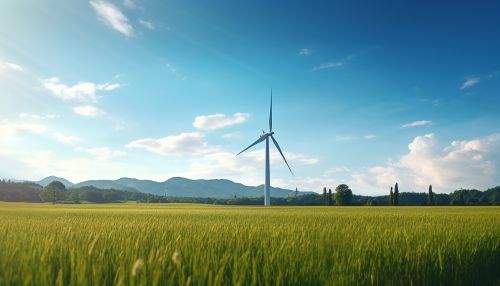Wind Energy
Introduction
Wind energy is a form of solar energy that is converted by the wind, which is generated by the uneven heating of the Earth’s surface by the sun. It is a renewable and sustainable form of energy that has a much smaller impact on the environment compared to burning fossil fuels.


History of Wind Energy
The use of wind energy dates back to 5,000 BC when people used sails to navigate the Nile River. Persians had also been using windmills since 500-900 AD for grinding grain and pumping water. The concept of harnessing wind energy for grinding grain spread rapidly throughout the region and later to the rest of the world. By the 11th century, people in the Middle East were using windmills extensively for food production; they introduced windmills to Europeans, who modified the design and mechanics for grinding grain and pumping water.
How Wind Energy Works
Wind energy is harnessed through the use of wind turbines. A wind turbine turns wind energy into electricity using the aerodynamic force from the rotor blades, which work like an airplane wing or helicopter rotor blade. When wind flows across the blade, the air pressure on one side of the blade decreases. The difference in air pressure across the two sides of the blade creates both lift and drag. The force of the lift is stronger than the drag, and this causes the rotor to spin. The rotor is connected to the generator, either directly or through a shaft and a series of gears (a gearbox) that speed up the rotation and allow for a physically smaller generator. This conversion of the force of the wind into a torque (rotational force) is how the generator captures the wind's energy.
Types of Wind Turbines
There are two main types of wind turbines: horizontal axis wind turbines (HAWTs) and vertical axis wind turbines (VAWTs). HAWTs are the most commonly used type, and they consist of a rotor with three blades that spin on a horizontal axis. VAWTs, on the other hand, have the main rotor shaft arranged vertically, which means they do not need to be pointed into the wind to be effective, unlike HAWTs.
Wind Energy and the Environment
Wind energy has a number of environmental benefits compared to other energy sources. It does not produce air pollutants or greenhouse gases. The wind is also abundant and inexhaustible, making wind turbines a sustainable way to generate electricity. However, wind turbines do have some environmental impact, including noise and visual impacts, and they can also pose a threat to wildlife, particularly birds and bats.
Advantages and Disadvantages of Wind Energy
Like all energy sources, wind energy comes with its own set of advantages and disadvantages. The advantages include its renewable nature, its low operating costs, and the fact that it does not produce any greenhouse gases. However, the disadvantages include its intermittent nature, the large amount of land required for wind farms, and the potential impact on local wildlife.
Future of Wind Energy
The future of wind energy is promising, with technological advancements making turbines more efficient and less expensive. Wind energy is one of the fastest-growing energy sources in the world, and its growth is expected to continue as the world seeks to reduce its dependence on fossil fuels.
